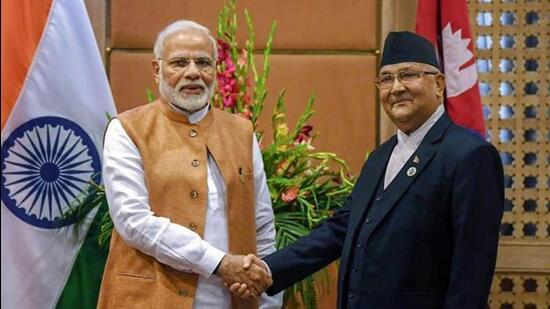By Arun Kumar Shrivastav
In Nepal, a new government under CPN-UML leader KP Sharma Oli has assumed power. Oli is set to seek a vote of confidence on July 21 in the parliament. Together, the coalition of CPN UML and Nepali Congress holds a comfortable majority with a combined total of 167 seats in the lower house, surpassing the required threshold of 138 seats. This makes Oli’s confidence vote a seemingly straightforward process.
Nepal, a small landlocked country known for its towering Himalayan mountains, holds significant geopolitical importance due to its strategic location between India and China, with both nations vying for influence. India maintains its second-largest diplomatic mission in the world in Nepal, underscoring Nepal’s strategic significance and India’s deep interest in the country’s affairs. The United States and many European countries minutely watch the developments in Nepal for their significance in the region’s geo-politics. However, China has also been actively increasing its influence in Nepal, notably through various infrastructure and development projects.
According to the Nepali version of the incident, India imposed an economic blockade on Nepal in 2015, citing concerns over the new constitution’s impact on the Madhesi community, who reside in the plains bordering India. This blockade strained relations between the two countries but was eventually lifted after several months, leading to a shift in Nepali public sentiment towards a more balanced foreign policy approach.
KP Sharma Oli previously served as Prime Minister but faced criticism for tilting towards China during his tenure, despite Nepal’s historical ties with India. His administration signed numerous agreements with China, although many have yet to materialize due to logistical challenges posed by Nepal’s difficult terrain compared to its easier access to India.
Following dissatisfaction with Oli’s pro-China stance, his government lost popularity, leading to his ouster in 2019. Subsequently, Pushpakamal Dahal ‘Prachanda’ assumed the role of Prime Minister with the support of Nepali Congress and CPN UML, navigating through multiple no-confidence motions during his tenure.
Now, with KP Sharma Oli’s return to power, the region watches closely to see how his leadership will impact Nepal’s delicate geopolitical balance and its relations with India and China. His upcoming confidence vote will be pivotal in determining the stability and direction of Nepal’s governance in the coming months.
A new government in Nepal needs to take a serious approach that addresses age-old issues such as unemployment and education. The key to sustainable solutions lies in long-term commitment and substantial investments. Nepal’s governance has been marked by political instability, hindering progress in nation-building and institutional development.
Achieving lasting results necessitates patient and committed participation from citizens, policymakers, and stakeholders alike. Central to Nepal’s future success is adopting a rational outlook and setting realistic expectations. Currently, the media and intellectuals often sensationalize political developments, perpetuating instability and distracting from crucial long-term goals vital for national development.
The recurring cycle of leadership changes, exemplified by shifts like those under KP Sharma Oli, illustrates the persistent challenge. Rather than focusing solely on geopolitical manoeuvres, Nepal’s path to prosperity hinges on inward reflection and sustained grassroots efforts over a decade or more. Only then can the nation meaningfully engage with external concerns, such as relations with India.
India would see the formation of a new government in Nepal as a significant opportunity to strengthen bilateral relations, particularly in sectors with vast untapped potential. Nepal’s energy landscape, notably in hydroelectric and renewable energy, presents promising avenues for collaboration. Given India’s substantial electricity demands, harnessing Nepal’s hydroelectric capabilities could prove mutually beneficial. Furthermore, strategic infrastructural projects such as rail routes through Nepal could enhance connectivity to India’s North East, complementing ongoing initiatives.
Eco-tourism emerges as another promising sector for bilateral cooperation, with Nepal offering pristine destinations like the Annapurna range, increasingly popular among high-budget travellers. India stands to benefit by bolstering investments in Nepal’s tourism infrastructure.
Economic ties are already robust, evident in Nepal being the seventh largest sender of remittances to India. Strengthening economic cooperation further could yield substantial mutual benefits beyond addressing minor disputes. Therefore, the focus for both nations should be towards maximizing economic synergies rather than dwelling on contentious issues.
As Nepal transitions with a new administration, the emphasis remains on nurturing a relationship rooted in economic prosperity and strategic cooperation.
In addition to addressing ongoing bilateral issues, Nepal holds significant potential as a mediator in regional conflicts. The flare-ups between India and China frequently dominate the spotlight. Nepal’s ability to foster peace among conflicting parties has a compelling prospect.
The geopolitical landscape of the Indian subcontinent and South Asia underscores Nepal’s potential role as a consensus-builder. For instance, amid Myanmar’s enduring military rule and civil unrest over the past three years, and the Rohingya crisis in Bangladesh need intervention. Kathmandu’s emergence as a peace facilitator would mark a notable achievement.
To transcend its current obsession of navigating between India and China, Nepal must broaden its international stature and engagement. Moving beyond regional confines, Kathmandu should explore alliances beyond its immediate neighbours. This strategic shift could elevate Nepal onto a global stage, positioning it as a pivotal player in international diplomacy. (IPA )


